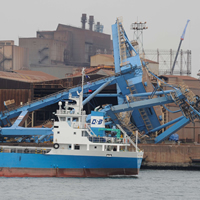Major aftershock shakes Japan

issued for the coast already devastated by last month’s massive quake and tsunami that crippled a nuclear power plant.
No damage from the quake, measured at magnitude 7.4 by the Japan Meteorological Agency, was detected at the Fukushima Daiichi plant and workers had been evacuated without reports of any injuries, operator Tokyo Electric Power Co (TEPCO) said. TEPCO said it was continuing to inject nitrogen into reactor No.1 after no irregularities were reported.
Engineers, who sealed a leak this week that had allowed highly radioactive water into the sea, are pumping nitrogen into one reactor to prevent the risk of a hydrogen gas explosion, and want to start the process in another two reactors.
There were no abnormalities in radiation levels around Tohoku Electric’s Onagawa nuclear power plant, where fuel rods are being cooled with just one outside power source, Japan’s nuclear safety agency said.
There were no immediate reports of injuries or damage elsewhere but people in areas covered by the tsunami warning should evacuate to higher ground, Japan’s NHK public television said.
Large parts of northern Japan were without electricity according to local media early on Friday.
Japan is struggling to bring the Fukushima Daiichi plant under control after the March 11 magnitude 9.0 quake and tsunami that followed, which killed or left missing, about 28 000 people.
Japan’s neighbours have sounded increasingly alarmed over the risk of radiation from the plant, while tourists are staying away in what should be the peak season, and the country seeks ways to cut power use.
The world’s worst nuclear disaster in 25 years is also raising concern over safety in the United States, which has more atomic reactors than any other country, especially at one plant which is similar to the one in Fukushima wrecked by last month’s 9.0 magnitude earthquake and tsunami.
TEPCO said late yesterday it did not expect it would have to dump any more contaminated water into the ocean after Saturday.
Earlier, TEPCO said the chance of a repeat of the gas explosions that damaged two reactors in the first days of the disaster was “extremely small”.
But as engineers battle multiple crises – some the result of efforts to try to cool reactors – officials admit it could take months to bring the reactors under control and years to clear up the toxic mess left behind at the plant 240 km north of Tokyo.
“Data shows the reactors are in a stable condition, but we are not out of the woods yet,” Chief Cabinet Secretary Yukio Edano told reporters.
The government has already set up a 20 km exclusion zone around the plant, banned fishing along much of the northeast coast and set up evacuation centres for the tens of thousands forced to leave their homes following the crisis.
Trace levels of radioactive material have been detected in the air in 22 Chinese provinces but the amounts did not pose a threat to health or the environment, China’s state news agency Xinhua said.
Earlier, China’s Health Ministry said traces of radioactivity in spinach had been found in three provinces.
In South Korea, some schools closed because parents were worried that rain could be toxic.
“We’ve sent out an official communication today that schools should try to refrain from outdoor activities,” an education official in South Korea said.
South Korea’s nuclear safety agency reported a small level of radioactive iodine and caesium particles in rain but said it was not enough to be a health concern. The few schools that closed were expected to reopen today if the rain stopped. – Reuters.










Comments